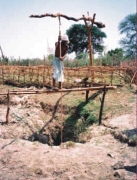/topics/climate-and-weather
Climate and Weather
Comparison of single and multiple flow direction algorithm for computing topographic parameters in TOPMODEL – A research report by National Institute of Hydrology
Posted on 18 Jul, 2010 08:16 PMThe report attempts to do a comparison of single and multiple flow direction algorithms for computing topographic parameters in TOPMODEL. Topography is an important factor that influences the physical phenomenon of rainfall-runoff. Undeniably, it plays a primary role in the gravity drainage within a basin. In the last decade, ever-developing computer techniques associated with the greater availability of terrain data in digital form has favored the production of physically based models, which have spatial variability of topography built into their structure.
Seasonal mapping of water bodies along the Andhra Pradesh coast using satellite data – A research report by the National Institute of Hydrology
Posted on 18 Jul, 2010 04:43 PMThe report presents the seasonal mapping of water bodies along the Andhra coast using satellite data to analyze the pre-monsoon and post-monsoon variations in the reservoirs. Water resources development be it construction of reservoir, anicut or irrigation canal, calls for mapping of the various water bodies to throw light on its behavior in different seasons in order to plan a judicious water management scheme.
Remote sensing methods are considered to be more appropriate than conventional methods for collection of such information owing to their capability to provide broad synoptic and repetitive coverage of the area in a multi-spectral mode.
Estimation of rainfall recharge in a coastal area through inverse groundwater modeling - A research report by National Institute of Hydrology
Posted on 18 Jul, 2010 02:29 PMThe study focuses attention on the use of inverse modeling technique for estimation of rainfall-recharge in a coastal aquifer. MODINV (Modular Inverse Model), which is software for parameter optimization of 3-D groundwater flow model, MODFLOW is applied to the Central Godavari delta in Andhra Pradesh to estimate the distributed rainfall-recharge during monsoon season.
Crop Water Requirement for Krishnai Irrigation Project – A research report by National Institute of Hydrology
Posted on 18 Jul, 2010 11:33 AMIn this report an attempt has been made to estimate the mean monthly reference crop evapotranspiration (ETo) for the Krishnai Irrigation Project in Assam. To undertake this analysis, the mean monthly climatological and physiographical data for the period of 1986 to 1994 has been collected from the Meteorological Department, Borjhar, Assam.
Drought characterization in arid and semi-arid climatic regions of India – A research report by National Institute of Hydrology
Posted on 16 Jul, 2010 11:03 PMThe report attempts drought characterization in arid and semi-arid climatic regions of India. Drought frequency and intensity are a function of the dimensionless climatic parameter derived as a ratio of mean annual potential evapotranspiration to mean annual precipitation (Ep/Pa).
A rapid geohydrological study of microwatersheds from Bolangir district, Orissa state - A report by ACWADAM
Posted on 16 Jul, 2010 03:50 PM This document by ACWADAM is a report of a rapid geohydrological assessment of some of the microwatersheds from parts of Bolangir district Orissa.
This document by ACWADAM is a report of a rapid geohydrological assessment of some of the microwatersheds from parts of Bolangir district Orissa.
Bolangir district in Orissa forms a part of one of the hottest and backward regions of India with low land-productivity, and opportunities and technologies for agriculture in the district remain relatively unexplored.
Vagaries of rainfall and the underlying hard-rock geology further compound the problem and limit agricultural productivity to a great extent. Given such natural uncertainties, systematic implementation of a watershed management programme is the most viable avenue to overcome the problems of this region.
Bolangir district was thus selected as pilot area to conduct a pre-feasibility exercise for planning of water resources management. ACWADAM, Pune was invited, along with Samaj Pragati Sahayog, Bagli to conduct this pre-feasibility exercise.
Development of regional flood frequency relationships using L-moments for South Bihar – A research report by the National Institute of Hydrology
Posted on 14 Jul, 2010 10:55 PMIn this study, regional flood frequency relationships have been developed using L-moments for South Bihar, in the alluvial plains of Indo-Gangetic basin and Kaimur-Chhotanagpur Santhal Pargana plateau. The annual maximum peak flood data of twenty-two gauging sites whose catchment areas vary from 11.7 to 3171 sqkm have been used. The mean annual peak floods of these sites vary from 29.15 cumec to 1293.2 cumec. Comparative regional flood frequency analysis studies have been carried out using some of the commonly used frequency distributions viz Extreme Value (EV1), General Extreme Value (GEV), Normal, Log Pareto (GPA) and Wakeby based on L-moments approach.
A modified SCS-CN based hydrologic model – A research report by National Institute of Hydrology
Posted on 12 Jul, 2010 09:37 PMThe Soil Conservation Services Curve Number (SCS-CN) method presented in this report has been applied to two large catchments in sub-humid regions of India and its performance evaluated. The variation of the curve number is examined and discussed and a critical evaluation of the employment of the single linear reservoir routing technique and linear regression technique presented.
Status report on hydrology of arid zones of India by the National Institute of Hydrology
Posted on 12 Jul, 2010 08:03 PMThis status report on "Hydrology of Arid Regions in India" compiles the scattered information on the subject. It is divided into nearly fourteen categories, covering sections like geology, rainfall, desertification of arid lands, position of groundwater in arid & semi-arid regions and dune landforms.
Bio-drainage – A research report by National Institute of Hydrology
Posted on 12 Jul, 2010 07:32 PMThe report attempts to provide solutions to the twin problems of waterlogging and salinity in the irrigated command area through various drainage or traditional reclamation measures viz controlling the intensity of irrigation, providing drainage system, lining, improving natural drainage, preventing seepage or adopting modern technology for application of water.





